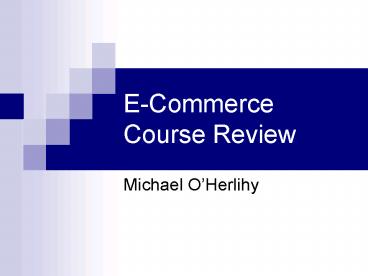ECommerce Course Review - PowerPoint PPT Presentation
1 / 21
Title:
ECommerce Course Review
Description:
Work off-line (no online verification needed) Accepting Credit Cards Online. Merchant Account ... a) Describe a typical online credit card transaction. ... – PowerPoint PPT presentation
Number of Views:60
Avg rating:3.0/5.0
Title: ECommerce Course Review
1
E-Commerce Course Review
- Michael OHerlihy
2
Agenda
- Course Review
- Individual Assignments
- Exam Questions
3
E-Commerce Introduction
- E-Commerce Definition
- E-Commerce versus E-Business
- Pure Versus Partial EC
- EC Organisations
- Bricks and Mortar
- Bricks and Clicks
- Clicks Only
- EC Domains
- B2B, B2C, C2C, C2B
4
Traditional Payment Methods
- Cash
- Check
- Credit Card
- Stored Value
- Accumulating Balance
5
Desirable Properties of Digital Money
- Universally accepted
- Transferable electronically
- Divisible
- Cant be stolen or forged
- Private (no one except parties know the amount)
- Anonymous (no one can identify the payer)
- Work off-line (no online verification needed)
6
Accepting Credit Cards Online
- Merchant Account
- Third Party Services Providers
- Virtual Malls
- Person to Person (P2P) Payment Systems
7
How an Online Credit Card Transaction Works
- Processed in much the same way that in-store
purchases are - Major difference is that online merchants do not
see or take impression of card, and no signature
is available - Card Not Present (CNP)
transactions - CNP transactions incur a higher fee
- Participants include consumer, merchant,
clearinghouse, merchant bank (acquiring bank) and
consumers card issuing bank
8
Typical E-Commerce Transaction
9
Vulnerable Points in an E-Commerce Transaction
10
Most Common Threats
- Most common threats
- Malicious code
- Hacking and cyber vandalism
- Credit card fraud/theft
- Spoofing
- Denial of service attacks
- Sniffing
- Insider jobs
11
Dimensions of E-Commerce Security
- Confidentiality ability to ensure that messages
and data are available only to those authorised
to view them - Integrity ability to ensure that information
being displayed on a Web site or
transmitted/received over the Internet has not
been altered in any way by an unauthorised party - Availability ability to ensure that an
e-commerce site continues to function as intended - Non-repudiation ability to ensure that
e-commerce participants do not deny (repudiate)
online actions - Authenticity ability to identify the identity of
a person or entity with whom you are dealing on
the Internet - Privacy ability to control use of information a
customer provides about himself or herself to
merchant
12
The Tension between Security and Other Values
- Security vs. ease of use the more security
measures that are added, the more difficult a
site is to use, and the slower the process
becomes - Security vs. desire of individuals to act
anonymously
13
SPAM
- Unsolicited e-mail, often of a commercial
nature, sent indiscriminately to multiple mailing
lists, individuals, or newsgroups - Directive 2002/58/EC, implemented as European
Communities (Electronic Communications Networks
and Services) (Data Protection and Privacy)
Regulations 2003 (SI 535/2003)in force 6
November 2003
14
Irish Legislation
- The new Irish laws also place restrictions on
direct marketing via telephone, fax, automated
calling system and, importantly, SMS and MMS, or
mobile spam - Positives
- It's opt-in, rather than opt-out
- Each spam counts as a separate offence
- Forging / disguising of originating header info
is prohibited - Negatives
- No private right of action
- Spamming to mailing lists is not prohibited
- No good against non European based spammers
15
Encryption
- The translation of data into a secret code
- To read an encrypted file, you must have access
to a secret key or password that enables you to
decrypt it - Unencrypted data is referred to as plain text
- Encrypted data is referred to as cipher text
- Two Types of Encryption
- Symmetric
- Asymmetric (public-key)
16
Major problems of Symmetric Encryption
- Data Integrity Receiver can not verify the that
a message has not been altered - Repudiation Receiver can not make sure that the
message has been sent by the claimed sender - Scalable Key Distribution
17
Asymmetric Public Key Encryption
- An important element to the public key system is
that the public and private keys are related in
such a way that only the public key can be used
to encrypt messages and only the corresponding
private key can be used to decrypt them - It is virtually impossible to deduce the private
key if you know the public key
18
Individual Assignments
19
Exam Questions
- 6 Questions Do 4
- 2 Questions on this Module
- Two Parts to each question
- A Part worth 15 Marks, B Part worth 5 Marks
- Identify, explain and give examples
20
Last Years Exam Question
- Traditional payment systems were never designed
for use in the digital world. As the Internet has
expanded and more consumers make online
purchases, the weaknesses of cash, cheques, and
credit and debit cards become more apparent. a)
Describe a typical online credit card
transaction. In your answer you must detail the
roles played by each of the five parties
involved. 15 Points Available 1 point for
mentioning each of the 5 parties and 2 additional
points for describing the process that party
plays. b) List five desirable properties of
digital money. - 5 Points Available 1 point for listing each
property.
21
Contact Details
- Michael OHerlihy
- Email michael_at_websteps.ie
- Course Site http//www.websteps.ie/tcd
- Telephone 01 440 3868
- Mobile 086 600 8710































